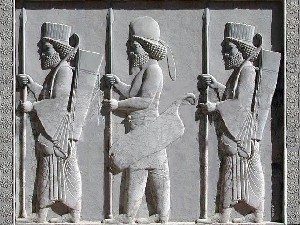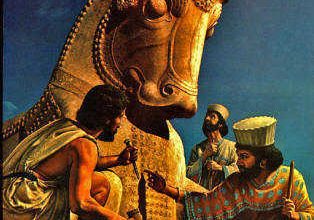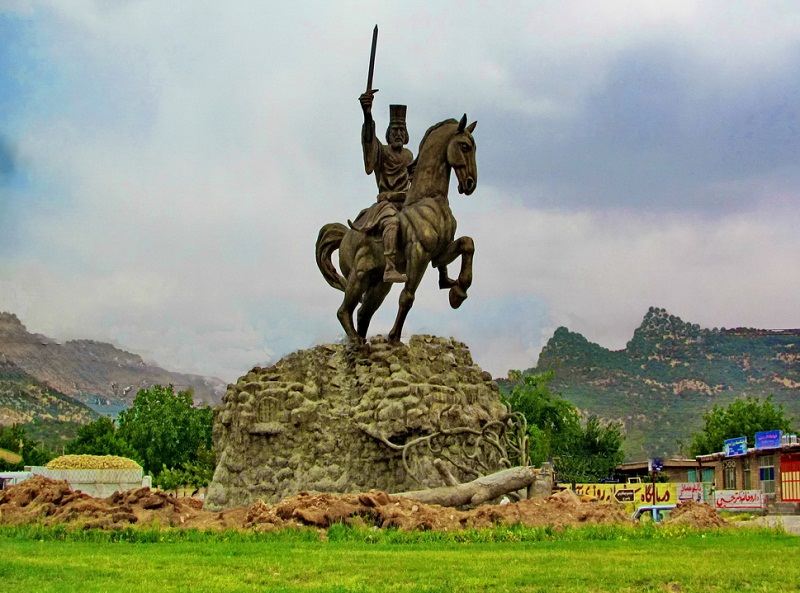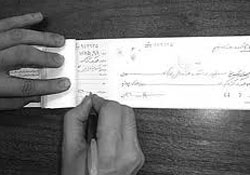Women's rights were three times higher than men's during the Achaemenid period
About 70 Last year, in 1913, during the excavations of the Institute of Oriental Studies of the University of Chicago under the supervision of Ernst Hertzfeld, an Iranian scholar, a collection of flower inscriptions was found in the northeastern part of Persepolis..
Women's rights were three times that of men during the Achaemenid period. This collection, which consisted of about 30 thousand tablets, belongs to 509 until the 494 It is written in Elamite cuneiform script. Four years later, this collection was entrusted to the University of Chicago for study. Since then, some of the results of the researchers' studies have been published..
Last year, in the spring of 2013, Dr. Gil Stein, the director of the Institute of Oriental Studies at the University of Chicago, 300 The flowers written from the translated texts of the Rampart of Persepolis were returned to Iran by the University of Chicago in anti-acid and anti-moisture boxes.. These documents, which have a lot of cultural value and tell a part of the cultural history of Iranians, were kept in the storage of the National Museum until now.. But after the classification and preparation of English and Farsi birth certificates, for the first time an exhibition of these plaques has been held in the National Museum until the end of June.. The display of this number of paintings, which are also categorized by subject, has been unprecedented in the world so far. But what information can be obtained from these boards?
Shahrukh Razmjo, head of the National Museum's Achaemenid Studies Center, explains: "more than 30 The nation was located in the territory of Achaemenid Iran.
On the one hand, Iran's borders extended from India to Yugoslavia and Bulgaria in Europe, and on the other hand, from Egypt, Ethiopia, and Libya in Africa to the borders of China and the plains of Siberia.. Administering such a large territory in 2500 The previous year required discipline and a very precise administrative organization, and the Achaemenids were able to manage this empire well for nearly two centuries with the help of their unique organization.. Achaemenid administrative documents were mostly written in Elamite script and language on flowers. In addition, other scripts and languages were used, such as Aramaic, which was mostly written with ink on skin, leather, and tablets.. The exhibited Elamite tablets are an example of Achaemenid administrative documents that include the payment of foodstuffs for various purposes by the government..
"There are a number of receipts that were given in exchange for receiving goods or food. Because money and coins were not widely used yet. At that time, Darius had just created the monetary system and the exchange system was still mostly done through food. Some of the texts contain religious payments. Such texts show that Iranian and Elamite clerics received duties from the government for vows to their gods or religious ceremonies, and interestingly, any of the Iranians or Elamites could receive duties from the gods and use them for another god..
It means that there was a very close cooperation between religions. In some texts, it is stated that the goods that were given to a god were handed over to the workers after the ceremony to be consumed.. The same texts of religious payments can give us information such as the worshiped gods or the religious ceremonies of the people of that day. For example, we learn from the texts that there was a ceremony called "Len".. We don't know the exact nature of this religious ceremony, but apparently it was similar to the anointing ceremony of Christians. The names of gods such as Ahuramazda, Mitra, Neryusang and Sepandarmed are also seen in these tablets and show the ancient worship of these gods.. Another interesting point is that the goddess Anahita has not been mentioned with all the history and position she has in the minds of Iranians, but there are payments for water, rivers and the holy mountain, which may not be unrelated to this goddess.. According to Shahrokh Razmjo's explanation, what is very important in this exhibition is the seal on one of these flower inscriptions, which is considered the oldest Achaemenid seal in the world.. This stamp work belongs to the year 500 BC or the 22nd year of Darius, and the seal itself belongs to Cyrus I, the grandfather of Cyrus the Great, that is, it belongs to the seventh century BC.
This stamp depicts a rider with a spear in his hand and a footman with spears passing through his body and a broken bow in his hand.. Cyrus the first introduces himself as such in this seal: "Koresh, the son of Chish Pesh, the king of the city of Anshan". That is, during the time of Darius, very old seals, related to the king several generations ago, were still used. This Stampi stamp is similar to today's stamps. In addition to stompy stamps, another type of stamp called cylindrical stamps is also displayed in this exhibition. These seals could create infinite shapes by rolling them on the flower. The use of seals was the same as today to formalize documents.. In this exhibition, a sample of a cuneiform writing pen is also displayed. This pen was recently found in the excavations of Dr. Ismail Yaghmai in "Tal Bandu" in Fars, and apparently it was used to write proto-Elamite script. (= Early Elamite) It was nine ancient Persian cuneiform. But anyway, it is the best example of an old writing pen. Razmjo says about the boards of other groups: "Other groups displayed include mothers' duties, travel duties, animals' duties, workers' duties, and calculation texts."
Then he gives explanations about each group as follows: Mothers who were apparently government employees and worked in the cities of Fars, i.e. ancient Persia (Because these texts are all related to the mentioned area), they received birthrights or special duties from the government. A review of salaries and wages shows that in some cases, even with equal jobs, women were paid three times more than men. Part of the trip is obligatory for travelers who come from different cities such as Kandahar, India, Sard, Egypt, Shush, Kerman and… had come, it would be given and a part would be given to the pioneers. In other words, the world's oldest postal system payment is recorded in these tablets. Pioneer couriers, called "Pyyardazish" in Elamite, carried the messages quickly along the roads of the empire, and this was the oldest and fastest postal system in the world that Darius founded.. Some plates have the aspect of a product label that was sent with the product itself. Some texts are also known as calculation texts. These texts are annual and include the report of payments, withdrawals and savings for the next year. These texts are tabulated just like today's audit texts and the lines of the tables are visible on the boards.
Computational texts have advanced mathematics, and to study them, one must master mathematics in addition to Elamite.
On most of the boards, especially the calculation boards, writings or signs can be seen in Aramaic script which is written with compound and shows that, from these texts, another archive was prepared which was written on skin or leather in Aramaic language and script and kept in another place. Been. On some boards, only a sign stating that it was copied is visible, and on others, "Nashq", which means "Copy has been removed", is written quite softly.
The purpose of archives is to have copies of original documents if they are lost. Some of the main sources of this work, including the research done by the University of Chicago on these tablets, especially the books prepared on the role of seals, have been displayed.. The Achaemenid Studies Center of the National Museum has also prepared a table of all the syllables used in the inscriptions of the Achaemenid period.. But the number of syllables in the Elamite script cannot be determined correctly. Because there may be several different forms for one shape. Also, the form of syllables differs in different Elamite periods.
But this table, flowers and a special pen for writing cuneiform called goh, which is carved from wood, allows the visitors to hold the flower in their hands and with the help of the table, write cuneiform syllables and practically the writing style of the ancient period. experience.
Not all Elamite tablets are clean, healthy and legible as we see in this exhibition. Many of the boards were chipped. Chopped boards, which have increased in number 35 The Achaemenid Studies Center of the National Museum has classified a thousand tablets in a long-term project and divided them into groups such as the role of secondary seals. (Text and border), text and pattern, stamp pattern, text, edge, brain, label and so on… has divided. An example of these parts is also displayed. These parts are often illegible and remain like a big puzzle, in order to study, you have to find the relevant parts and put them together. Also, some pieces of clay have been found in this collection, which shows that these tablets were stored in clay jars. In this exhibition, burnt strings, a sample of a knot and a human hair can be seen, which were obtained from inside the panels.. The ropes and knots are burnt due to the fire of Persepolis by Iskandar Sokhthand, and the yarn obtained is white in color.. Hair becomes white and hard over time, and even after a hundred years, hair with its original color cannot be found, unless it is under special conditions.. Therefore, the approximate age of its owner cannot be determined based on hair color. Both sides of all these plates have holes. Because there were strings passing through all these plates and two ends of the string came out from both sides of the plate and it was shaped like a fake..
In this way, they could hang the plates somewhere for archives. Usually, the left side of the plates is a flat surface that is the place of the thumb of the left hand. Because when writing, they usually held the tablet in their left hand and wrote from left to right. In this part, the tablet was sealed and actually became official.
If the writing continued, they would turn the tablet around and continue writing on the back of the tablet. If the writing filled the back of the tablet, it was left as it was, and the flat surface on the left side was stamped to give it legitimacy.. But if there was an empty space behind the inscription, that space was sealed so that no one else could add anything there.. (Just like today when they close the end of administrative letters or checks.)
"Shahrokh Razmjo" explains that all these boards are similar to today's factors and they never give us information directly.. The information should be pulled from inside them. For example, the weight units of that period used to pay for goods are known from these plates: "Bar" is the weight unit of solids and "Marish" is the weight unit of liquids.
In some texts, the name of the secretary who wrote the text is added at the bottom of the text. Apparently, those who have a name were a famous person who had a special administrative position and when they put their name at the bottom of the text, they wanted everyone to know who they were.. But how was that wide and long administrative and economic organization managed?
Razmjo says: "This organization of food payments as money for various purposes was managed under the supervision of a person named Parnakeh, who was Dariush's uncle.. He had deputies and these deputies themselves had subordinates who determined the obligatory and obligatory amounts of different regions. Different regions had different officials. There were people who carried the goods and delivered them to the regions, and there were also those who received the goods.. All of these were members of a very organized and detailed organization of salary payments to different people.
Can it be understood from these tablets that prisoners or slaves were also employed in this system?
Razmjo says in response to this question: "In the inscriptions, people are mentioned as free people who work and get paid. They are completely under surveillance, not in terms of security and protection, in terms of knowing how much everyone has worked and how much they should be paid, so that their salaries are not reduced or delayed.. The salary situation also shows that the salary was very high in some cases. But they did not use captives or slaves or prisoners for work.
It is possible that they had prisoners, but they did not use them for construction work. Artists were invited for this purpose and the artists worked according to contracts. There are various documents in this case. Like the invitations written by the satrap of Egypt for Egyptian artists. The names of the artists, their nationality, their work and the amount of their salary are also recorded in the texts of the treasury.








In addition to its very interesting content, this site also has a very beautiful format
Thank you for your beautiful thinking
In the book from the language of Darius, written by the German mathematician Marie Koch, the rights of men were equal and depended on the type of activity and their position, and only in a few examples did men have more rights and rights, such as the share of a woman who had a pregnant son was twice the amount of food in has considered.
How do you know if it's a boy or a girl? ?
They were doing an ultrasound ?
Men's and women's salaries were equal, and sometimes women's salaries were higher.